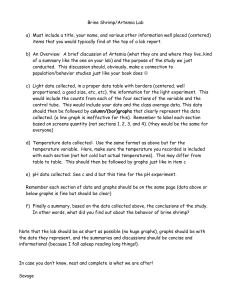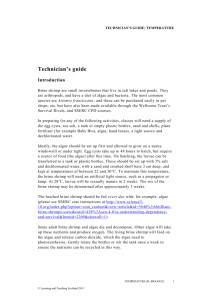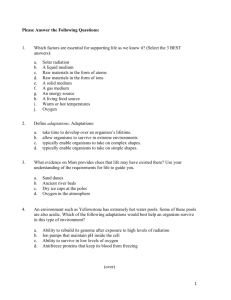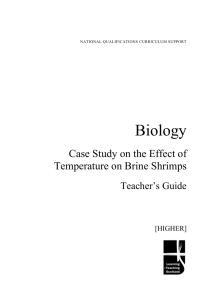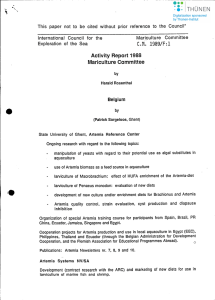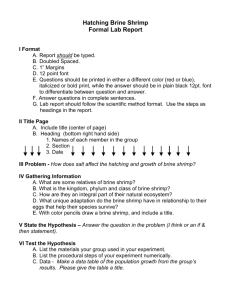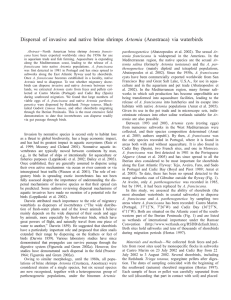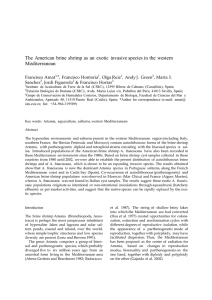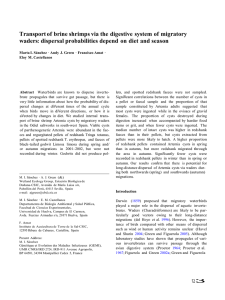Student information sheet Name:
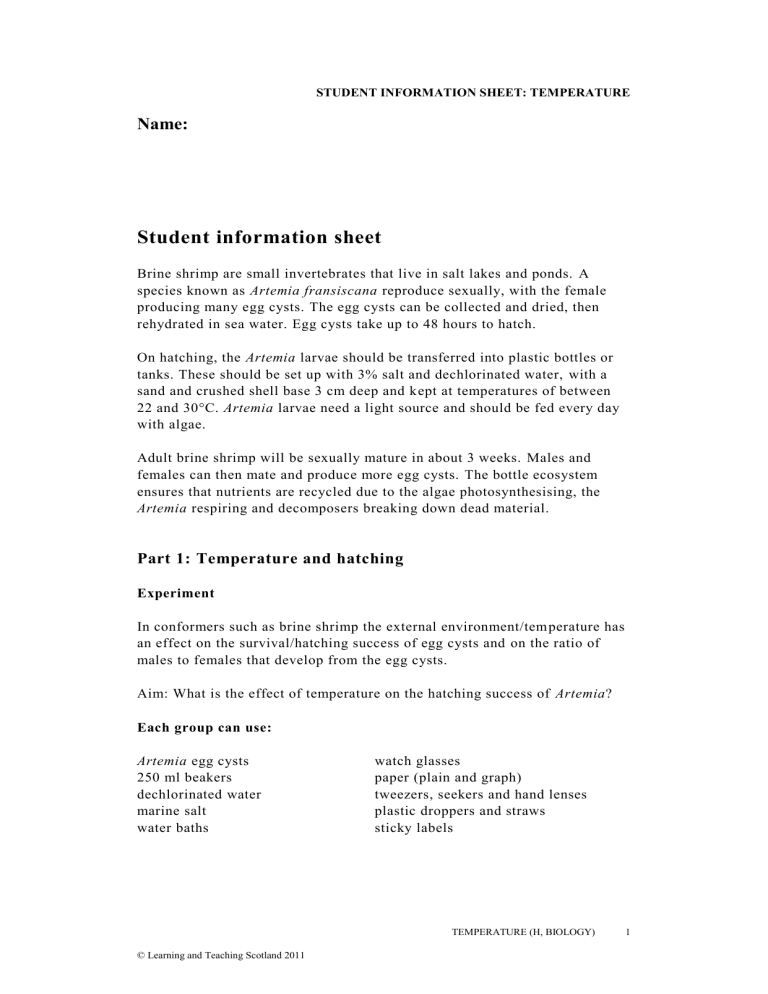
STUDENT INFORMATION SHEET: TEMPERATURE
Name:
Student information sheet
Brine shrimp are small invertebrates that live in salt lakes and ponds. A species known as Artemia fransiscana reproduce sexually, with the female producing many egg cysts. The egg cysts can be collected and dried, then rehydrated in sea water. Egg cysts take up to 48 hours to hatch.
On hatching, the Artemia larvae should be transferred into plastic bottles or tanks. These should be set up with 3% salt and dechlorinated water, with a sand and crushed shell base 3 cm deep and k ept at temperatures of between
22 and 30°C. Artemia larvae need a light source and should be fed every day with algae.
Adult brine shrimp will be sexually mature in about 3 weeks. Males and females can then mate and produce more egg cysts. The bottle ecosystem ensures that nutrients are recycled due to the algae photosynthesising, the
Artemia respiring and decomposers breaking down dead material.
Part 1: Temperature and hatching
Experiment
In conformers such as brine shrimp the external environment/tem perature has an effect on the survival/hatching success of egg cysts and on the ratio of males to females that develop from the egg cysts.
Aim: What is the effect of temperature on the hatching success of Artemia ?
Each group can use:
Artemia egg cysts
250 ml beakers dechlorinated water marine salt water baths watch glasses paper (plain and graph) tweezers, seekers and hand lenses plastic droppers and straws sticky labels
TEMPERATURE (H, BIOLOGY) 1
© Learning and Teaching Scotland 2011
STUDENT INFORMATION SHEET: TEMPERATURE
Name:
Temperature
(°C)
Group 1 Group 2 Group 3 Group 4 Group 5 Average
Each beaker should have 100 eggs cysts added to it. Your teacher will demonstrate how to count out 100 eggs as follows:
Put a small quantity of eggs onto a white sheet of paper .
Dab some of the eggs onto a small, moistened piece of paper and count out
100 using a hand lens, seekers, etc.
Add the paper and egg cysts to a beaker egg side down, and remove the paper after a few minutes with tweezers.
After 48 hours, the number of larvae that h atch can be counted for each temperature. To do this, cut the end off a large dropper (cut off the top 1 cm 3 ) and use this to remove samples of the shrimp into small beakers. Hand lenses can be used to count the number of larvae hatched. Larvae are small, but will be an orange/yellow colour and will be moving in the salt water solution.
Note : Your experiment should be set up to ensure reliable results. Why is it good experimental procedure to allow the beakers to come to the required temperature before adding the egg cysts? How can class data be collated to improve reliability? How can class results be displayed in a suitable format?
2 TEMPERATURE (H, BIOLOGY)
© Learning and Teaching Scotland 2011
STUDENT INFORMATION SHEET: TEMPERATURE
Name:
Draw a conclusion from your results and explain how temperature affects hatching, and why.
Identifying male and female brine shrimp
If the Artemia are allowed to develop in tanks/bottles, their sex can be identified after 2–3 weeks.
What are the main differences between the male and female Artemia ?
The Artemia body segments in the thorax can also be used to determine the ir development stage (from 0 to 18 segments).
© Learning and Teaching Scotland 2011
TEMPERATURE (H, BIOLOGY) 3
STUDENT INFORMATION SHEET: TEMPERATURE
Name:
Part 2: Research on temperature and development of Artemia
Temperature (°C) Average time taken to reach final development stage (hours)
20 402.55
22.5
25
27.5
30
280.50
194.77
160.32
137.21
32.5 126.69
What conclusion can you draw from these results?
How did the researcher ensure the results were reliable?
How could you improve the reliability of the results further?
Estimate how such a precise time was recorded for the development of the brine shrimp.
What variables would need to be kept the same for each experiment?
The final development of a brine shrimp is when its body has 17 segments.
Beyond this, it increases in mass. Look at the information below, showing the dry mass of the brine shrimp against time.
4 TEMPERATURE (H, BIOLOGY)
© Learning and Teaching Scotland 2011
STUDENT INFORMATION SHEET: TEMPERATURE
Name:
Why do we use the dry weight of the Artemia as a measurement of their mass?
Describe the processes involved in getting a dry weight measurement.
What conclusion can you draw from these results?
© Learning and Teaching Scotland 2011
TEMPERATURE (H, BIOLOGY) 5

